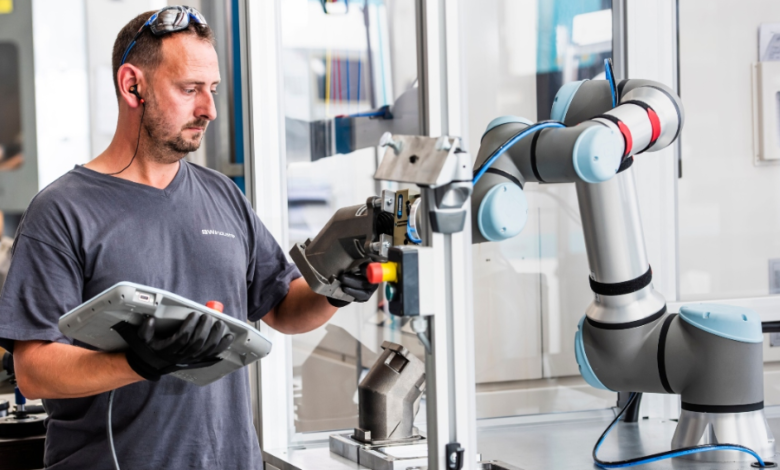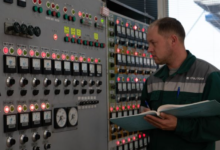Top Cobot Application Transforming Modern Manufacturing

A cobot application is transforming modern manufacturing by enabling businesses to achieve higher efficiency, improved safety, and greater flexibility on the production floor. Unlike traditional robots that work in isolation, cobots are designed to collaborate with human workers, handling tasks such as welding, packaging, assembly, and quality inspection with precision. This seamless integration of human and machine not only reduces costs but also drives innovation across industries. In this article, we’ll highlight the top cobot applications that are revolutionizing modern manufacturing.
How Cobots Transform Modern Manufacturing
Collaborative robots (cobots) are revolutionizing manufacturing by improving efficiency, safety, flexibility, cost-effectiveness, and innovation.
Efficiency: Faster, Smarter Production
Cobots excel at repetitive and precision tasks such as assembly, welding, and quality inspection. Unlike humans, they operate without fatigue, which speeds up production, reduces cycle times, and ensures consistent quality. This allows manufacturers to meet higher demand more efficiently while maintaining product standards.
Safety: Protecting Workers
Equipped with advanced sensors and safety features, cobots can work safely alongside humans without cages. They handle hazardous tasks such as welding or moving dangerous materials, reducing workplace injuries.
Flexibility: Quick to Adapt
Cobots are easily reprogrammed or reconfigured for different tasks, enabling manufacturers to adjust to new product designs or changing production needs with minimal downtime.
Cost Savings: Lower Operational Expenses
Cobots often cost less than traditional industrial robots and require less infrastructure. Their easy integration, reduced labor needs, and minimized errors lead to faster returns on investment.
Innovation: Enabling Smarter Workflows
By integrating with AI, machine learning, and other advanced technologies, cobots enable smarter workflows, predictive maintenance, and real-time quality control, driving continuous improvement and innovation.
Cobots enhance efficiency, safety, flexibility, cost-effectiveness, and innovation in manufacturing. Their collaborative nature makes them indispensable for modern, optimized, and future-ready production environments.
See also: Advancements in Sheet Metal Bending Technology
Top Cobot Applications in Modern Manufacturing
Collaborative robots (cobots) are transforming manufacturing by boosting productivity, safety, and precision. Here are key areas where they make an impact:
Top 1: Assembly and Sub-Assembly
Cobots are well-suited for repetitive and precise tasks such as screwdriving, applying adhesives, and inserting parts. By handling these jobs, they ensure consistent product quality, reduce errors, and lessen worker fatigue. This speeds up production and allows employees to focus on more complex or higher-value tasks, ultimately boosting overall productivity.
Top 2: Welding
Cobots perform precise welding using advanced sensors, ensuring strong and consistent welds. They also improve worker safety by handling dangerous tasks, reducing exposure to heat, fumes, and other hazards.
Top 3: Packaging and Palletizing
Cobots help pack and stack products quickly, making the supply chain more efficient. They also handle heavy or repetitive lifting, reducing strain on workers and preventing injuries.
Top 4: Quality Inspection and Testing
Cobots with vision systems can spot defects and errors that humans might miss. This automated inspection ensures products meet quality standards, reduces mistakes, and helps maintain a strong brand reputation.
Top 5: Machine Tending and Material Handling
Cobots can load and unload machines, reducing downtime and keeping production running smoothly. They also help move parts and materials efficiently around the facility, ensuring everything is available when needed.
Cobots improve efficiency, safety, and product quality across a wide range of tasks. Their versatility makes them essential tools in today’s competitive manufacturing environment.
Collaborative Robots vs. Industrial Robots: Key Differences
- Human Collaboration & Safety
- Cobots: Built to work safely alongside humans, using sensors and force-limiting technology; no protective barriers are needed.
- Industrial Robots: Require fenced-off areas for safety, limiting human interaction.
- Flexibility & Deployment
- Cobots: Easy to reprogram and switch between tasks quickly, making them ideal for dynamic or customized production.
- Industrial Robots: Task-specific and rigid; retooling and reprogramming are complex, time-consuming, and costly.
- Cost & ROI
- Cobots: Lower upfront cost, minimal infrastructure requirements, and fast return on investment, often within a year.
- Industrial Robots: Higher initial investment and maintenance costs; best suited for large-scale, repetitive production.
- Precision & Adaptability
- Cobots deliver high precision using AI, vision systems, and force feedback, allowing them to handle delicate or changing tasks with ease.
- Industrial Robots: Extremely precise but less flexible when tasks or environments change.
Cobots are safe, flexible, cost-effective, and human-friendly, making them ideal for collaborative and dynamic manufacturing. Industrial robots handle repetitive, high-volume tasks well but aren’t as adaptable or human-friendly as cobots for shared or varied production.
The Future of Cobot Applications in Manufacturing
The future of cobots in manufacturing is set to bring transformative changes, driven by artificial intelligence (AI) and smart sensors.
AI and Smart Sensors: Smarter, More Adaptive Cobots
AI and advanced sensors are making cobots increasingly intelligent and adaptable. They can perform complex tasks such as real-time quality inspection, predictive maintenance, and dynamic task adjustments. For instance, AI-powered vision systems can detect tiny defects with accuracy surpassing human capabilities.
Smart sensors also enable cobots to interact naturally with their environment and human coworkers, enhancing safety and operational efficiency. This synergy is expanding cobot applications across diverse manufacturing sectors.
Growing Adoption Among SMEs
Cobots are becoming a popular choice for small and medium-sized enterprises (SMEs) due to their affordability, flexibility, and ease of deployment. Designed to work safely alongside humans without extensive safety barriers, cobots reduce workplace hazards and require minimal training. As cobots grow more versatile, SMEs can harness them to improve productivity and competitiveness.
Cobots are becoming intelligent, adaptable, and collaborative partners in manufacturing. With advancements in AI and sensor technology, and increasing adoption by SMEs, cobots play an important role in making manufacturing more efficient, innovative, and human-centered.
How to Get Started with Cobots
Introducing cobots into your operations is easier than you might think. Here’s a simple guide:
Identify Automation Opportunities
Look for tasks that are repetitive, dangerous, or require high precision. Common examples include assembly, welding, material handling, quality inspection, and packaging.
Assess Your Needs
Examine your workflow to see where a cobot can add value. Consider task complexity, available space, and how humans will interact with the cobot.
Choose the Right Cobot and Provider
Work with a trusted cobot provider to pick the right robot for your needs. Ensure they offer support for integration, training, and ongoing technical help.
Plan Integration
Create a clear roadmap for implementing the cobot, including setup, programming, and safety measures. Start with pilot tasks before rolling out full-scale deployment.
Train Your Team
Give employees hands-on training to safely work alongside cobots. Cover programming basics, task monitoring, and troubleshooting.
Monitor and Optimize
Track how the cobot affects performance, productivity, and safety. Adjust workflows and programming as needed to get the most benefit.
Following these steps helps businesses increase efficiency, improve safety, and scale operations effectively, making cobots a practical and user-friendly way to embrace advanced automation.
Conclusion: Embracing Cobots for a Future-Ready Workforce
Collaborative robots, or cobots, are transforming manufacturing by combining advanced automation with human skills. Their flexibility, safety, and precision help businesses work more efficiently. By taking on repetitive or dangerous tasks, cobots free human workers to focus on problem-solving and creative work.
This collaboration not only boosts productivity but also improves job satisfaction, creating a more dynamic and resilient workforce. For companies looking to stay competitive, adopting cobots is a smart strategy. They enhance efficiency, improve product quality, and encourage innovation, offering real benefits that drive growth and success. Embracing cobots isn’t just about new technology, it’s about building a future where humans and robots work together to achieve shared goals.





